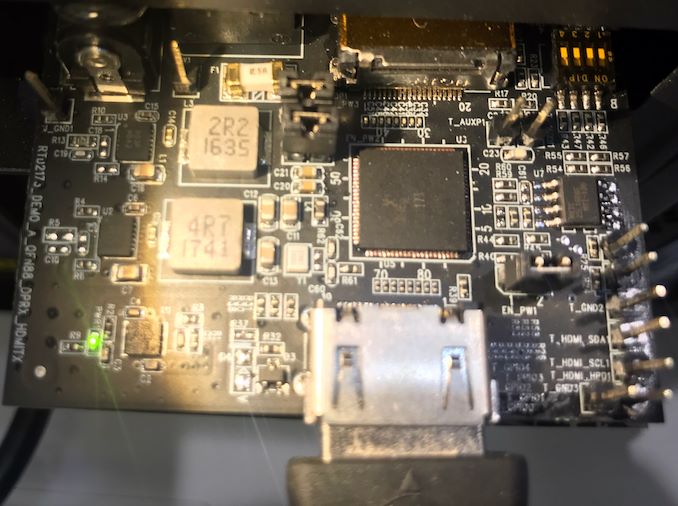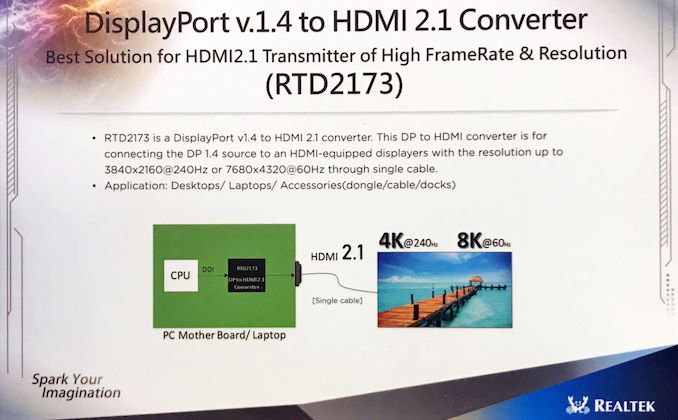Realtek Demonstrates RTD2173 DisplayPort 1.4 to HDMI 2.1 Converter
by Anton Shilov on June 13, 2019 12:00 PM EST- Posted in
- Monitors
- Displays
- HDMI
- Trade Shows
- Realtek
- HDMI 2.1
- Computex 2019

Realtek is working on a chip that will convert DisplayPort 1.4 signals to HDMI 2.1 signals. The RTD2173 converter will enable makers of notebooks, motherboards, docks, and other applications to build devices supporting next-gen HDMI output using current-generation graphics processors that only support DisplayPort 1.4 outputs. Meanwhile, such products will have certain peculiarities.
A number of modern high-end televisions featuring an 8K resolution are outfitted with HDMI ports that are technically ready to receive HDMI 2.1 signals, but are not marketed as HDMI 2.1 because they have not been certified by the HDMI Forum. Once the certification program for HDMI 2.1 is available, producers of Ultra-HD TVs can validate their devices and issue appropriate firmware updates to formally add HDMI 2.1 support. Makers of HDMI cables will release their Ultra High Speed HDMI (48G) cables around the same time.
Meanwhile, at present there are no GPUs that support HDMI 2.1 connection, and even Intel’s 10th Gen Core processors codenamed Ice Lake never mention support for this standard. Therefore, to connect an 8K TV featuring an HDMI 2.1 interface to PCs (or other applications featuring a DP 1.4) special converters or adapters will be needed. This is where Realtek’s RTD2173 chips comes into play.
The RTD2173 chip converts DisplayPort 1.4 signals to HDMI 2.1 signals to enable up to 3840×2160@240 Hz or 7680×4320@60 Hz resolution using a single cable. Keep in mind that the maximum bandwidth supported by a DP1.4 interconnection using the HBR3 data rates is 32.4 Gbps, which is enough for 8Kp60 when Display Stream Compression 1.2 is used. Meanwhile, the maximum bandwidth of HDMI 2.1 is 48 Gbps and it does not need to use DSC 1.2 for 8Kp60.
Realtek’s RTD2173 converter has been implemented in silicon and once it receives certification from the HDMI Forum, it can be used by makers of PCs, dongles, docks, adapters, cables, and other products. Expects devices with HDMI 2.1 output to be available in the coming quarters.
| Want to keep up to date with all of our Computex 2019 Coverage? | ||||||
 Laptops |
 Hardware |
 Chips |
||||
| Follow AnandTech's breaking news here! | ||||||












31 Comments
View All Comments
JasonAT - Thursday, June 13, 2019 - link
Are HDMI 2.1 and DP1.4a w/ DSC1.2 equivalent at 4k resolution at high refresh rates? It seems like HDMI 2.1 still has advantages as far as chroma/color bit depth, not to mention additional standard features like VRR.TheUnhandledException - Friday, June 14, 2019 - link
DSC supports multiple compression rates. So since HDMI 2.1 has a higher underlying bitrate than DP 1.4 it would require a lower compression rate to hit the same target (resolution, bit depth, frequency). I am unsure if it would be noticeable visibly but it is a benefit in favor of HDMI 2.1repoman27 - Thursday, June 13, 2019 - link
Your math certainly checks out on the bandwidth calculations, but I'm guessing this chip may not even support DSC, because both of the listed resolutions / frame rates are possible at 10 bpc for DisplayPort 1.4 HBR3 and HDMI 2.1 FRL using 4:2:0 chroma subsampling. Which according to the HDMI Forum qualifies as "fully uncompressed video"!I highly doubt VRR is in the offing either, because it would pose considerable technical challenges, but we'll have to wait until Realtek posts more detailed specs to know for sure what this thing can do.
TheUnhandledException - Friday, June 14, 2019 - link
Yeah that is a good point. If it doesn't support DSC then it may just be enabling those resolution and framerates using 4:2:2 or 4:2:0 subsampling (which would be worse PQ).jeremyshaw - Monday, June 17, 2019 - link
It shouldn't be too bad. Microsoft got it working in millions of Xbox One S/X consoles, and those use an off-the-shelf DP--> HDMI chip from TI (not AMD's native HDMI output block). Sony uses a custom LSPCon from Panasonic to do something similar in the PS4, though without HDMI Forum VRR support.joevt - Sunday, August 11, 2019 - link
The max bit rates listed in the article don't include the encoding on the wire. DisplayPort uses 8b/10b so 32.4 Gbps becomes 25.92 Gbps. HDMI 2.1 uses 16b/18b so 48 Gbps becomes 42.67 Gbps.The 62.06, 49.65, 32.27 Gbps numbers are correct (they are the bitrate required for the resolutions without adding encoding, they include the extra pixels for horizontal and vertical blanking).
It does not follow that 32.27 requires DSC in the DisplayPort 1.4 case when the reader sees the 32.4 Gbps number instead of the corrected 25.92 Gbps number.
Mikewind Dale - Sunday, June 16, 2019 - link
Awesome.I can't figure out why, but I've never been able to get DisplayPort to work. I've tried several different brands of DisplayPort cables, and no matter what I do, my displays randomly flicker and lose signal.
By contrast, the same displays work fine with HDMI. So I just use active DisplayPort to HDMI adapters to connect my Radeon RX 580 to my computer monitors.
I can't figure out why. It's obviously not a problem with the cables, because I tried several brands. And it's not a problem with the DisplayPort outputs, because they work fine when combined with DisplayPort to HDMI adapters. Maybe it's a problem with the DisplayPort inputs on the monitors? But in any case, I can't get my computer monitors to work unless I use HDMI.
So I'm glad to see that DisplayPort to HDMI adapters continue to be developed.
jeremyshaw - Monday, June 17, 2019 - link
Same. DP has been problematic for me in ways that HDMI and DVI never have been (DVI holding a slight edge over HDMI). This is across many monitors (Dell, LG, BenQ, etc), GPUs (Intel, AMD, and Nvidia), OS's (Win 7-10, OSX, and several Linux distributions, though nothing decent). Of course, I now have a box of DP cables, too. Most often, the link just up and fails after turning the monitor off then on. Bonus points for turning on the computer first, then the monitor (DP fails), starting with the wrong input (using a source via HDMI, then switching to DP for my PC causes the audio output to disappear), just flat out failing after working fine for hours, etc.I now have grown to dislike displayport. I only put up with it since my GSync monitor requires DP to even function. Once that's gone, DP can go away, too.
It has gotten better over the years. The issues still remain, but the frequency has gone down. I can still reliably trigger DP failing by powercycling the monitor, though. Shame, since I was trying out a dual monitor setup, and I don't always need 2 monitors blaring at once (this is also the reason why switching inputs fail - I had another device hooked up to the HDMI input of one of the monitors).
I will say, Win 10 1903 with a Nvidia GPU running a Gsync monitor, has been the least problematic setup yet. This only only exhibits the audio issue (so far). Of course, numerous laptops run their internal displays with eDP just fine... Given all that, I'm willing to bet a lot of the DP issues I've experienced come from a bad chain of firmware and software.
fschwartz - Saturday, July 20, 2019 - link
"A number of modern high-end televisions featuring an 8K resolution are outfitted with HDMI ports that are technically ready to receive HDMI 2.1 signals, but are not marketed as HDMI 2.1 because they have not been certified by the HDMI Forum."This is technically inaccurate.
Per the HDMI Forum (https://www.hdmi.org/manufacturer/hdmi_2_1/), "Q: Can I use “HDMI 2.1” in my marketing
A: You can only use version numbers when clearly associating the version number with a feature or function as defined in that version of the HDMI Specification. You cannot use version numbers by themselves to define your product or component capabilities or the functionality of the HDMI interface. And please note that NO use of version numbers is allowed in the labeling, packaging, or promotion of any cable product."
This means you will not see TV's marketed as "HDMI 2.1" to distinguish them from other TV's. "HDMI 2.1" can only be used in marketing materials when referring to an HDMI 2.1 specific feature. It is more likely (as we see today), that TV manufacturers will refer to individual HDMI 2.1 features their TV supports (ALLM, eRAC, QFT, QMS, VRR), and I suspect there is no requirement for all HDMI 2.1 features to actually be supported in a single device.
In this regard, I believe the presentation of this Realtek device is misleading, because it is highly unlikely that it will support all HDMI 2.1 features when converting from DisplayPort.
LGC94K120fps - Sunday, February 23, 2020 - link
It is now almost Q2 of 2020... where is this adapter?! Anyone know of it yet? Thanks!